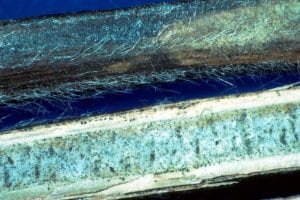Bob Mulrooney, Extension Plant Pathologist; bobmul@udel.edu
Charcoal rot was identified this week on a late Group III soybean variety. Charcoal rot is favored by dry weather that follows wet weather soon after planting. Usually irregularly sized patches of infected stunted, dying plants are seen in the field, but sometimes you can see individual plants in the row infected, and dead or dying. When this happens you see scattered plants dying either singly or several in a row flanked by healthy ones. Carefully dig up plants and look at the roots and lower stem. They will often be gray and if you scrape the gray lower stem or roots you can see many small black flecks that look like the tissue was covered with powered charcoal. Often if the plants are dead and you split the stems the pith is full of these tiny microsclerotia as well. Rotation will help to some degree as well as planting later maturing varieties. This disease will always be a threat to Group II and III soybeans planted full season, if planting in fields previously cropped to soybeans when a season is wet early and then the crop is drought stressed during pod fill like this year. Double-crop soybeans are not usually infected with charcoal rot. We will likely be seeing more of this disease as the month progresses.
 Charcoal rot on split soybean stem. Note the powdered charcoal appearance of the microsclerotia imbedded in the stem tissue and scattered in the pith.
Charcoal rot on split soybean stem. Note the powdered charcoal appearance of the microsclerotia imbedded in the stem tissue and scattered in the pith.
